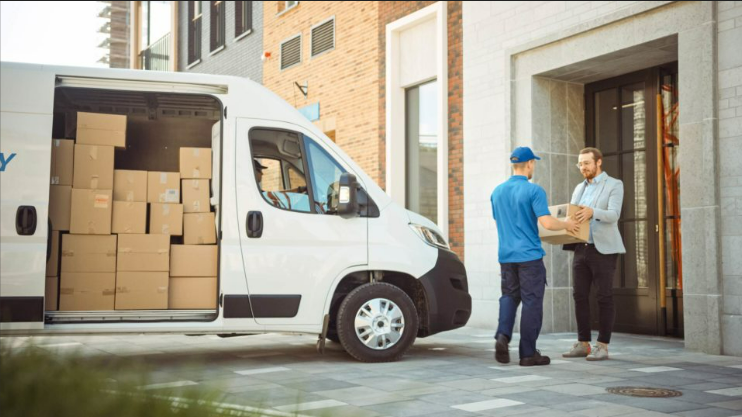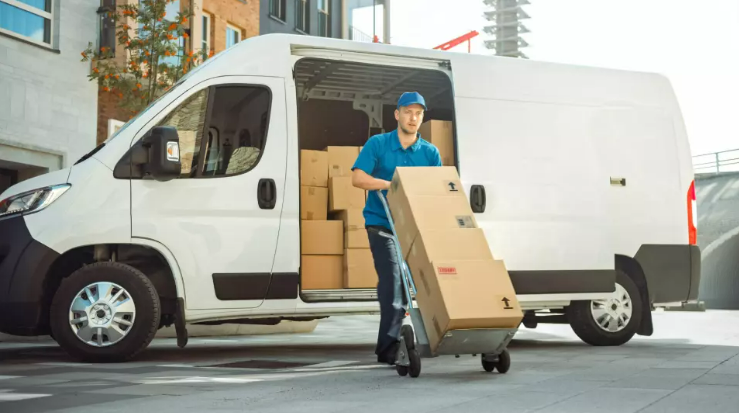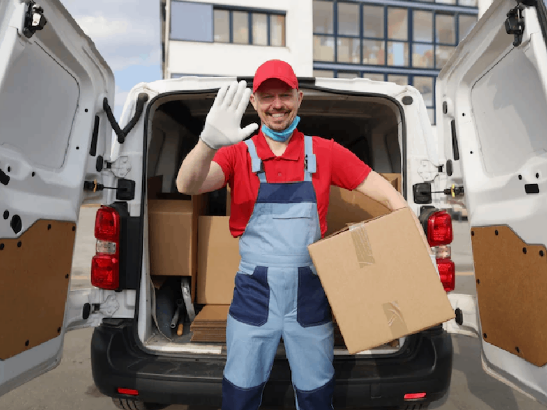The future of last-mile delivery in freight is evolving rapidly as businesses and logistics companies face increased pressure to meet customer demands for speed, efficiency, and sustainability.

As e-commerce continues to grow, the need for reliable, fast, and cost-effective delivery methods has never been greater. This article explores the key trends shaping the future of last-mile delivery, focusing on technological advancements, sustainability efforts, and the impact on the freight industry as a whole.
Let's Get Straight To The Point
The future of last-mile delivery in freight is evolving rapidly due to rising e-commerce demands for speed, efficiency, and sustainability. Key trends shaping this future include the use of autonomous vehicles, electric vehicles (EVs), AI and machine learning for route optimisation, crowdsourced delivery, and the implementation of smart lockers and pickup points.
These innovations aim to reduce delivery costs, address traffic congestion, and meet environmental goals. Freight companies are increasingly adopting data-driven technologies, and sustainability is becoming a key focus.
To stay competitive, companies need to leverage these advancements to improve customer satisfaction, reduce costs, and enhance operational efficiency in a dynamic market.
What is Last-Mile Delivery?

Last-mile delivery refers to the final leg of the delivery process, where goods are transported from a distribution centre or warehouse to the end customer. In freight, this is the final stage in getting products from large transportation hubs to urban areas, residences, or retail locations.
The challenges associated with last-mile delivery are significant, especially in densely populated urban areas, where traffic congestion, environmental concerns, and customer expectations all play a role. As freight people in the industry look for innovative solutions, understanding these challenges is crucial for shaping future logistics operations.
Current Challenges in Last-Mile Delivery
1. Cost Management
The cost of last-mile delivery has been a persistent challenge for freight companies. It's typically the most expensive segment of the supply chain, accounting for a significant portion of total delivery costs. Factors such as fuel, vehicle maintenance, labour, and customer service contribute to this high price point.
2. Traffic Congestion And Delays
Urbanisation has led to increased congestion, making timely deliveries difficult. Freight vehicles often face delays due to traffic, which can cause missed delivery windows and increased costs.
3. Customer Expectations
E-commerce customers have raised the bar, demanding quicker deliveries at lower prices. With the rise of same-day delivery and even on-demand delivery options, freight companies must adapt to meet these expectations without sacrificing profitability.
4. Environmental Concerns
As the push for sustainability grows, freight companies face pressure to reduce their carbon footprints. This includes finding ways to deliver goods more efficiently and using environmentally friendly vehicles, such as electric trucks and bikes, for urban deliveries.
Key Trends Shaping the Future of Last-Mile Delivery
1. Autonomous Vehicles
One of the most significant developments in last-mile delivery is the rise of autonomous vehicles. These vehicles, including drones, self-driving cars, and delivery robots, are poised to transform the freight industry by providing faster and more efficient deliveries with minimal human intervention.
The Role of Drones in Last-Mile Delivery
Drones are particularly suited for last-mile deliveries in urban areas. They offer the potential for rapid, cost-effective deliveries, especially for small packages. As drone technology advances and regulations evolve, we can expect a greater number of freight companies to adopt this solution.
Self-Driving Vehicles
In addition to drones, self-driving vehicles are expected to play a critical role in reducing costs and improving the speed of last-mile deliveries. These vehicles will eliminate the need for drivers, reduce human error, and operate 24/7 without rest, making them a valuable asset in the logistics sector.
2. Electric Vehicles And Sustainable Options
The future of last-mile delivery will also be heavily influenced by the adoption of electric vehicles (EVs) and other sustainable transportation methods. As freight people look to reduce the environmental impact of their operations, electric trucks and vans will become increasingly common in urban delivery fleets.
The Need for Green Logistics
Sustainability in logistics is no longer optional. Companies are under increasing pressure from governments and customers to reduce their carbon emissions. By incorporating electric vehicles into their fleets, freight companies can significantly lower their environmental impact. Moreover, the use of electric vehicles aligns with global efforts to reduce greenhouse gas emissions and combat climate change.
Urban Freight Consolidation Centers
To further enhance sustainability, some cities are creating urban freight consolidation centres. These centres serve as hubs where goods can be collected, sorted, and redistributed in smaller, more efficient vehicles, reducing congestion and pollution in urban areas. This model is becoming increasingly popular in Europe and is likely to expand to other regions.
3. Data-Driven Logistics
The integration of big data and artificial intelligence (AI) is transforming how last-mile delivery is managed. By analysing data from various sources, companies can optimise routes, predict demand, and track shipments in real-time.
Optimising Routes with AI
AI and machine learning are being used to optimise delivery routes, taking into account factors such as traffic patterns, weather conditions, and real-time delays. This technology enables freight companies to make data-driven decisions that improve delivery times and reduce costs.
Real-Time Tracking
Real-time tracking allows both companies and customers to monitor the status of deliveries as they happen. This level of transparency enhances customer satisfaction and provides freight companies with the data they need to troubleshoot and resolve any issues quickly.
4. Crowdsourced Delivery
Crowdsourcing has become an increasingly popular model for last-mile delivery, especially in the e-commerce space. Companies are tapping into local, freelance delivery drivers through apps and platforms, reducing the need for large delivery fleets.
Benefits of Crowdsourced Delivery
Crowdsourced delivery offers several advantages. It allows companies to scale their operations quickly, reduce labour costs, and tap into the flexibility of a gig economy. Additionally, this model can reduce congestion in urban areas by using local drivers who are already familiar with the area.
Challenges of Crowdsourcing
However, crowdsourcing also comes with its challenges. Ensuring the reliability of delivery drivers, maintaining a high level of customer service, and ensuring security can be more difficult when using independent contractors instead of full-time employees.
5. Smart Lockers And Pickup Points
Another trend that is likely to shape the future of last-mile delivery is the use of smart lockers and pickup points. These are secure locations where customers can pick up their packages at their convenience, eliminating the need for home deliveries altogether.
Smart Lockers
Smart lockers are automated, self-service kiosks that allow customers to retrieve packages after they are delivered. These lockers are typically located in high-traffic areas, such as shopping centres, train stations, and apartment buildings. This reduces the need for delivery personnel to make multiple attempts to deliver to the customer’s home and helps decrease delivery costs.
Pickup Points
Pickup points are another solution that helps reduce the cost and environmental impact of last-mile delivery. Customers can have their packages delivered to local stores, convenience shops, or designated hubs where they can collect them at their convenience. This model is particularly effective for urban environments where home delivery might not always be feasible or desired.
How Technology is Driving the Future of Last-Mile Delivery
1. Artificial Intelligence And Machine Learning
As discussed earlier, AI and machine learning are central to the evolution of last-mile delivery. By analysing large amounts of data, AI algorithms can predict delivery times, optimise routes, and even forecast demand. This technology is already being used by freight companies to improve efficiency, reduce delays, and enhance the customer experience.
2. Internet Of Things (IoT)
The Internet of Things (IoT) is enabling smarter and more connected delivery systems. IoT devices can track the location and condition of goods in real-time, providing valuable insights to both customers and freight companies. Additionally, IoT-enabled sensors can monitor factors such as temperature, humidity, and vibration, ensuring that sensitive items are delivered safely and on time.
3. Blockchain For Supply Chain Transparency
Blockchain technology is also playing a role in transforming last-mile delivery. By offering a secure and transparent ledger of transactions, blockchain can help reduce fraud, ensure product authenticity, and improve traceability throughout the supply chain. This is especially important in industries where tracking and verifying goods are critical.
The Impact of Last-Mile Delivery on Freight Companies
1. Cost Reduction
The advancements in technology and the rise of new delivery models like crowdsourcing and autonomous vehicles are helping freight companies cut costs. By adopting these solutions, companies can reduce operational expenses related to fuel, labour, and vehicle maintenance.
2. Improved Customer Satisfaction
As freight people continue to innovate in last-mile delivery, customer satisfaction will improve. Faster, more reliable, and more flexible delivery options mean that customers will experience fewer delays, better communication, and more convenient delivery windows.
3. Increased Competition
As the market for last-mile delivery becomes more competitive, freight companies will need to differentiate themselves through innovative services, better pricing, and a commitment to sustainability. The companies that are able to adapt to these new trends will be the ones that thrive in the future.
Conclusion

The future of last-mile delivery in freight is set to be shaped by technological advancements, sustainability initiatives, and evolving customer demands. By leveraging autonomous vehicles, electric vehicles, AI, and crowdsourcing, freight companies will be able to create more efficient, cost-effective, and environmentally friendly delivery systems.
As freight people continue to explore new solutions and innovations, the logistics industry will experience a transformation that benefits both businesses and customers. For companies in the freight industry, staying ahead of these trends will be crucial in ensuring long-term success in an increasingly competitive and dynamic market.
FAQs
What Is Crowdsourced Delivery?
Crowdsourced delivery involves using local freelance drivers to deliver packages. This model allows companies to scale quickly and reduce costs by tapping into the gig economy. While this offers flexibility, it also comes with challenges related to reliability, customer service, and security.
How Are Smart Lockers And Pickup Points Changing Last-Mile Delivery?
Smart lockers and pickup points are secure locations where customers can retrieve their packages at their convenience, eliminating the need for home deliveries. This reduces delivery costs, helps ease congestion in urban areas, and offers customers more flexible delivery options.
How Do AI and Machine Learning Impact Last-Mile Delivery?
AI and machine learning help optimise delivery routes, predict demand, and improve overall efficiency by analysing large datasets. This allows freight companies to make data-driven decisions, reduce delays, and enhance the customer experience.
How Does The Internet Of Things (IoT) Enhance Last-Mile Delivery?
IoT devices enable real-time tracking of shipments and monitoring of environmental factors like temperature and humidity. This allows both companies and customers to track the status of deliveries and ensures that sensitive goods are delivered in optimal conditions.
What Is The Role Of Blockchain In Last-Mile Delivery?
Blockchain provides a secure, transparent ledger for tracking shipments throughout the supply chain. This technology can help reduce fraud, ensure product authenticity, and improve traceability, which is especially important for industries dealing with sensitive or high-value goods.
